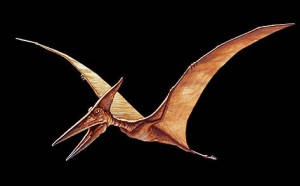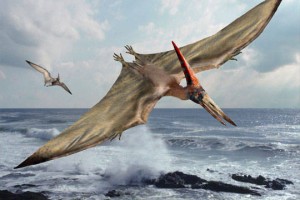Pterosaur And Pterodactyl Facts And Myths
Whatever you do, don’t call them ‘flying dinosaurs‘!
These flying reptiles lived alongside dinosaurs in a variety of environments across the Earth from the late-Triassic to the end of the Cretaceous period (225 to 65 million years ago).
They ranged in size from Just a few centimetres to more than 12 metres, mostly feeding on fish while some scavenged dead animals and ate insects inland.
The wing of the pterosaur was unique, a large membrane suspended from a hugely expanded fourth finger. Pterosaurs are largely regarded as the first vertebrates to achieve sustainable powered flight, although the largest relied mainly on the wind and gliding to stay in the air.
There is much contention among palaeontologists as to whether these flying reptiles should be classed as dinosaurs, but the physical similarities are plain to see nonetheless.
Of all pterosaurs, the giant Quetzalcoatlus is the largest – in fact it is the largest known flying animal of all time. With a wingspan of up to 15m and a head the size of a car, the Quetzalcoatlus ruled the sky in the Late Cretaceous period (100 to 65 million years ago).
It is widely believed that Quetzalcoatlus fed on living dinosaurs, unlike other pterosaurs who preferred fish and dead animals, to fuel its enormous metabolic needs. Despite its incredible size this giant reptile weighed no more than 250kg due to the hollow bones associated with pterosaurs.
 Pterosaurs ultimately faced extinction after more than 150 million years at the same time as the dinosaurs, conquering every single continent in the process.
Pterosaurs ultimately faced extinction after more than 150 million years at the same time as the dinosaurs, conquering every single continent in the process.
- Read also Plesiosaurus Dinosaur
- Read also Velociraptor Facts
Pterodactyl
The pterodactyl is arguably the most famous pterosaur. Its iconic features were characteristic of many pterosaurs, although a longer neck and a shorter tail ensured it was more suited to flight than its earlier ancestors, the rhamphorhynchoids.
Pterodactyl facts
 Head – The skulls of pterosaurs acted as a rudder in flight, with some later evolving rich ornamentation on top to attract mates.
Head – The skulls of pterosaurs acted as a rudder in flight, with some later evolving rich ornamentation on top to attract mates.
Walk, don’t run – Early pterosaurs struggled to walk with their wings closely attached to their legs.
Hollow bones – Pterosaurs were very light and able to fly thanks to their hollow bones filled with air sacs.
Size – With its wingspan and body measuring over a metre, pterodactyl was not the largest pterosaur.
Mouth – The long jaws allowed it to hunt fish, using its small teeth to grab them out of the water.
- Read also T-Rex Facts
- Read also Sauropods Facts
Flying with wings
The hollow bones of the pterosaurs led many scientists to believe that their wings could not produce the power needed to achieve flight from a standstill without wind assistance. Recent fossil evidence has indicated that smaller pterosaurs could achieve sustainable flight, although the larger creatures still struggled to get airborne without help.
Air bags and breathing
The 2009 study showed that the pterosaurs had a pneumatic airbag system and a precisely controlled skeletal breathing pump that supported the airflow through the lungs analogous to today’s birds.
The presence of the subcutaneous air bag system at least in some pterodactylaids would further reduce the density of live animals.
Nutrition, habitat and reproduction
Pterosaurs were probably hunters and carnivores. Early pterosaurs with long tails were probably mostly fed with fish and squid and lived on the shores of the sea or other water areas. One sign of this was the long teeth that acted like fish traps, perfect for capturing and retaining fish.
They lived in large colonies like today’s sea birds. Later pterosaurs were probably fed on insects. One very unusual pterosaur from South America, Pterodaustro, had very long and extremely thin teeth that served as a trap for fish. Probably filtered water through them and fed plankton like today’s flamingos.
Pterosaurs were Archosaurs who bore eggs. This is clearly proved with discovery of one fossilized embryos from the Early Cretaceous period (about 121 million years) in Liaoning Province in Northeast China. The discovered egg was a little smaller than the chicken and contained a well-preserved skeleton, and skin and tissue wrinkles could be detected on the wings.
Discovery of the first pterosaurs
Like dinosaurs, after their discovery, pterosurs caused a huge fascination.
Fossils of pterosaurus belong to the first found fossils of land vertebrates at all and have been investigated since the beginning of the history of paleontology at the beginning of the 19th century.
The first pterosaurus was described by Cosimo Alessandro Collini in 1784. Very well preserved remains from southern England and Germany made them very popular among scientists
Among the first discovered species are Dimorphodon macronyx, discovered by Mary Anning in the Lias form at Lyme Regis, followed by Rhamphorhynchus and Pterodactylus from the late jury in the plate limestone at Solnhofen.
The first pterosaurs
 The first pterosaurs appeared in the late triad period about 228 million years ago. Only pectoral bones have been found in the pterosaur from that period, and complete skulls and skeletons are rare.
The first pterosaurs appeared in the late triad period about 228 million years ago. Only pectoral bones have been found in the pterosaur from that period, and complete skulls and skeletons are rare.
The early species are identified primarily by their teeth, which had a few pointed tips. The teeth of later species have only one tip and are oblong and elongated.
All Triassic and early-Jurassic pterosaurs had long tails, and many stood out with very long teeth, for example, Rhamphorhynchus.
Most of the most complete pterosaur fossils from Triassic originate from Italy: from limestone to Zorzin at Cene in Lombardy and from the Preone valley in the Alps.
Jurassic pterosaurs
In Jurassic, there have been major evolutionary changes in the pterosaur. They spread across the globe and occupied a variety of habitats. Long-tailed pterosaurs in this period mainly had long teeth that are to its tip narrowed. Some types of teeth were toothed, but most of them were smooth.
Long-tailed pterosaurs disappeared in mid-Jurassic. Early jura developed short-lived pterosaurs, which had a very reduced tail, shorter teeth and longer bones of the wrist.
Cretaceous pterosaurus
In the Cretaceous, the largest species of pterosaurs developed, and this was also the case with dinosaurs and other animal groups (pleiosaurs, mosasauri, ichthaurus). In this period lived only short-tailed pterosaurs.
Big pterosaurs lived all over the world, but there were also small species. These smaller pterosaurs were in direct competition with birds that have recently developed and spread all over the world.
Until the 1970s, North American Pteranodon was considered the largest pterosaurus because the range of its wings was about 8 meters (26 ft) . When Quetzalcoatlus (named after the Aztec god Quetzalcoat) was discovered, by measuring the mass of his skull and comparing with the same in other pterosaurs, a 12 meters (40 ft) wingspan was obtained.

